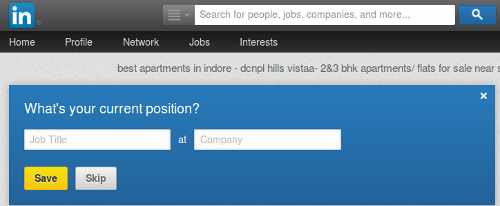10 Linkedin Flaws That Always Disturb Me
By Rakesh Raman
Linkedin, the self-proclaimed professional network, is no exception. It’s also a part of the same chaotic trend that is persistently happening in the online world.
Twitter and Facebook are among the other two online social media irritants. Why?
Twitter is for short-cutters who can’t articulate their thoughts and randomly put anything and everything – from the cough of their cat to the color of their mat – on the microblogging site in their broken English language.
And Facebook – which is the biggest data junkyard in the world – is for idle digital zombies who don’t have any other means to kill their time and use Facebook to dump everything – lifted quotes, pictures, videos, their sex scores, and whatnot.
Similarly, Linkedin is another annoyance that is becoming a pain in the neck for me, at least – and perhaps for others who understand the meaning of social or professional networking.
Here I count 10 problems that are extremely disturbing for me on Linkedin.
1. Wrong Connections
I have over 2,000 connections on Linkedin. When I enter the site, it tells me that these 2,000-odd connections link me to over 19 million (yes, you read it right) professionals. Where are they, by the way?
In the past two years, I have not seen even 20 active connections on Linkedin. Most always stay in deep hibernation. Then why is Linkedin trying to hoodwink me by telling that I have 19 million in my network? What do I do with this useless number?
2. Job Updates
In the Updates area, the messages regarding job changes are among the most common updates. Perhaps, people change their jobs as they change their outfits. This is an extreme paradox particularly when unemployment is the order of the day.
Linkedin won’t stop there. It irritates me with its “Say congrats on the new job!” message. How many congrats should I say in a day? Bunkum!
3. Ambiguous Analysis
Under the heading “Who’s Viewed Your Updates,” Linkedin never tells me who has viewed my updates. Instead, it shows me some meaningless number that I can never use as a parameter of analytics.
Is that all? No. In the same section, “Your update’s making the rounds” is another piece of falsehood. What exactly does it mean? Nothing. Linkedin doesn’t tell me how many people click the link that I post. In a purple circle, it shows me the number of views.
This information has no significance at all and Linkedin fails to tell me how it has counted these views.
4. Time-Wasters
Like Facebook and Twitter, Linkedin too is crowded with idle souls. The biggest engagement that I see on Linkedin is with those childish arithmetic hijinks – such as “2 + 2 = 4, 2 + 3 = 5, 2 + 4 = ?”
Is this some professional networking? Such people never write or contribute any sensible information because they are either illiterates or educated illiterates. Yes, I mean it.
While such people should be thrown out of the network, ironically Linkedin counts them in the number of registered users to falsely impress its investors and advertisers.
5. Rude Users
Most Linkedin users lack etiquette. I get frequent messages such as: “I would like to invite you to join my group on LinkedIn.”
Without addressing me by name or explaining about the message, they throw this insipid message in my message box. It hits me like a stone blow on my head.
While every Tom, Dick, and Harry can create a group on Linkedin, how many do you expect me to join? Worse, Linkedin doesn’t give me any option to block such silly invites.
6. Spam Messages
I get dozens of spam messages in my message box from different users who are otherwise never visible on Linkedin. They send these group / mass messages, which are either very long, or not readable, or they’re not at all relevant for me.
Obviously, I report them as spam. But that doesn’t put an end to my pain. Just after a couple days, the same users send me more spam because Linkedin’s spam filtering is flawed.
7. New Connections
The Linkedin Updates area is always cluttered with thumbnails of people with the message “10 people have new connections” or “…has a new connection”. I wonder what people do with such a surfeit of connections when they can’t write even a single straight sentence in their posts.
And why is Linkedin informing me about this mindless expansion of their network by different users? Strange. Why can’t this useless information be kept in the background?
8. Profile Reminders
Linkedin keeps asking me “What’s your current position?” every time I go to my Profile page. If I don’t want to change my profile information, you have no business disturbing me repeatedly. Do you understand, Linkedin?
If you’re so concerned about me, your backend system should be intelligent enough to know that if your message is going unheard, you should stop sending it after a specific number of times. Won’t that be the right thing for you and your users?
9. Skills Endorsement
Likewise, on my Profile page, Linkedin keeps displaying “Your connections… and 12 others have endorsed you for new skills and expertise!” while expecting me to reciprocate.
But the trouble is I don’t know any of these users who have endorsed me. And in all probability, they don’t know the work that I do and for which they have endorsed me.
Similarly, I don’t know what they do because they’re hardly visible on Linkedin. Then how do you expect me to endorse their skills? And what’s the point in repeatedly displaying this disturbing information on my Profile page?
10. Top Updates
In the dropdown menu under “All Updates”, there are two options: Top and Recent. Mostly, Top posts are displayed on my Updates section. And strangely just a picture with “… has a new photo.” message keeps hanging there for hours together, ignoring other posts which have more Likes or Comments.
Linkedin won’t tell me on what basis it selects the top updates. And why can’t these top updates keep scrolling down instead of sticking there like a poster?
– – –
These are some of the observations that I have on Linkedin. People who understand digital media know that these are serious user experience (UX) flaws that exist on all social media sites including Facebook, Twitter, and Linkedin.
And these networking sites are ignoring these flaws completely because they offer their services free of charge to the users. And most users don’t understand the online UX subtleties.
As a result, the number of users on these sites may be mushrooming, but they hardly ensure any value to the advertisers who want to display their ads on a social media site, such as Linkedin. Thus, the pain persists – at least for serious users like me. Are you listening, Linkedin?
By Rakesh Raman, the managing editor of RMN Company.
You also can read: More Articles by the RMN Editor, Rakesh Raman
















